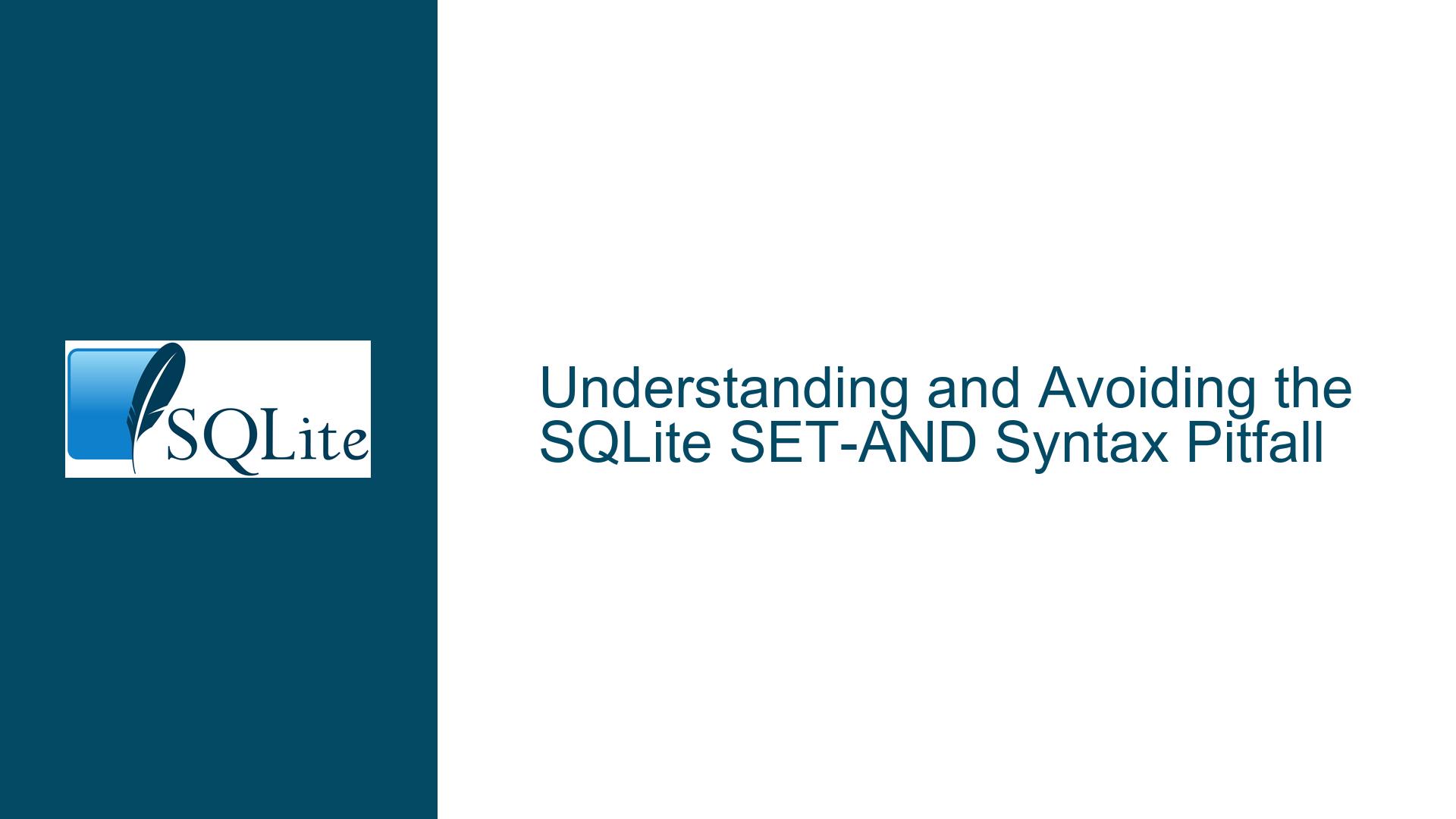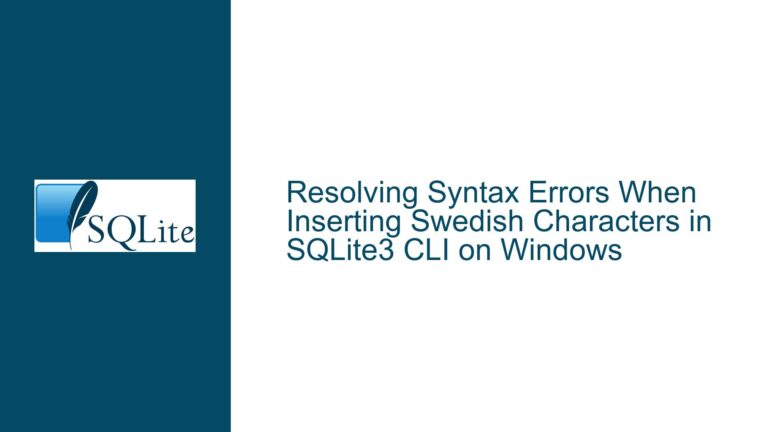and Avoiding the SQLite SET-AND Syntax Pitfall
Issue Overview: Misusing AND in SQLite UPDATE Statements
The core issue revolves around the misuse of the AND operator within the SET clause of an UPDATE statement in SQLite. This misunderstanding often leads to unintended behavior, where developers mistakenly treat AND as a separator between multiple column assignments rather than recognizing it as a boolean operator. This confusion can result in logical errors that are difficult to diagnose, especially for those new to SQL or SQLite.
In SQLite, the UPDATE statement is used to modify existing records in a table. The SET clause specifies the columns to be updated and the new values they should receive. A typical UPDATE statement looks like this:
UPDATE table_name
SET column1 = value1, column2 = value2
WHERE condition;
However, when developers mistakenly use AND instead of a comma to separate column assignments, the SQLite parser interprets AND as a boolean operator within an expression. This leads to a logical expression being evaluated rather than multiple column assignments being performed. For example:
UPDATE table_name
SET column1 = value1 AND column2 = value2
WHERE condition;
In this case, column1 is set to the result of the boolean expression value1 AND column2 = value2, which is likely not the intended behavior. This can cause unexpected results, especially if value1 and column2 are not boolean values, leading to implicit type conversions and further complications.
Possible Causes: Why the SET-AND Misunderstanding Occurs
The misuse of AND in the SET clause can be attributed to several factors, including a lack of understanding of SQL syntax, confusion between different SQL dialects, and the influence of other programming languages where AND might be used differently.
One of the primary reasons for this confusion is the similarity between SQL and other programming languages. In many programming languages, AND is used as a logical operator within conditional statements, and developers might inadvertently carry this usage over to SQL. However, in SQL, AND is strictly a boolean operator used to combine conditions in the WHERE clause or other conditional expressions. It is not used to separate assignments in the SET clause.
Another contributing factor is the lack of immediate feedback when such a mistake is made. SQLite, like many other databases, will not throw an error when AND is used incorrectly in the SET clause. Instead, it will interpret the statement as a boolean expression, which may not produce an error but will result in incorrect data being written to the database. This silent failure can make it difficult for developers to identify the root cause of the issue.
Additionally, the syntax of SQLite’s UPDATE statement can be misleading to those who are not familiar with its nuances. The SET clause is followed by a list of column assignments, each separated by a comma. When AND is used instead of a comma, it changes the meaning of the statement entirely, but this is not immediately obvious to someone who is not well-versed in SQLite’s syntax.
Troubleshooting Steps, Solutions & Fixes: Correcting and Preventing SET-AND Errors
To address the issue of misusing AND in the SET clause, developers must first understand the correct syntax for the UPDATE statement in SQLite. The SET clause should always use commas to separate column assignments, and AND should only be used as a boolean operator in conditional expressions.
When troubleshooting an UPDATE statement that is not behaving as expected, the first step is to carefully examine the SET clause to ensure that commas are used correctly. If AND is found in the SET clause, it should be replaced with a comma. For example, the incorrect statement:
UPDATE table_name
SET column1 = value1 AND column2 = value2
WHERE condition;
Should be corrected to:
UPDATE table_name
SET column1 = value1, column2 = value2
WHERE condition;
In cases where the UPDATE statement is complex and involves multiple columns and conditions, it may be helpful to break the statement down into smaller parts and test each part individually. This can help isolate the issue and ensure that each column assignment is correct.
Another useful technique is to use SQLite’s PRAGMA statement to enable stricter syntax checking. For example, the PRAGMA foreign_keys and PRAGMA integrity_check commands can help identify issues with the database schema or data integrity that may be related to incorrect UPDATE statements.
To prevent this issue from occurring in the future, developers should adopt best practices for writing SQL statements. This includes:
Consistent Syntax Review: Always review the syntax of SQL statements, especially when copying and pasting code from other sources. Ensure that commas are used correctly in the
SETclause and thatANDis only used as a boolean operator.Use of Linting Tools: Utilize SQL linting tools or integrated development environment (IDE) features that can automatically detect and highlight syntax errors in SQL statements. These tools can help catch mistakes before they are executed.
Education and Training: Invest in education and training for developers to ensure they have a solid understanding of SQL syntax and best practices. This can include formal training courses, online tutorials, or peer code reviews.
Code Reviews and Pair Programming: Implement code reviews and pair programming practices to catch potential issues early in the development process. Having a second set of eyes on the code can help identify mistakes that might otherwise go unnoticed.
Testing and Validation: Thoroughly test all SQL statements, including
UPDATEstatements, to ensure they produce the expected results. This can include unit tests, integration tests, and manual testing in a development environment before deploying to production.Documentation and Examples: Maintain clear documentation and examples of correct SQL syntax within the development team. This can serve as a reference for developers and help reinforce best practices.
By following these steps and adopting best practices, developers can avoid the pitfalls associated with misusing AND in the SET clause and ensure that their SQLite UPDATE statements are both correct and efficient.
In conclusion, the misuse of AND in the SET clause of an SQLite UPDATE statement is a common issue that can lead to unexpected behavior and data corruption. By understanding the correct syntax, identifying the root causes of the issue, and implementing best practices for writing and reviewing SQL statements, developers can avoid this pitfall and ensure the integrity of their databases.






